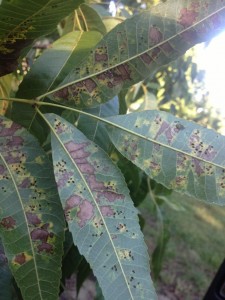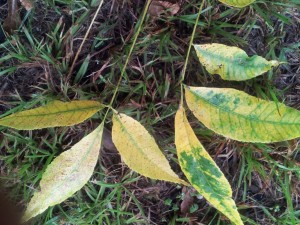The 2018 pecan crop is virtually made. Every nut I have cut of every variety I have looked at over the last two weeks is full of kernel. By the middle of last week, in addition to Pawnee, which is about ready for harvest in many orchards, I was seeing shuck split on Lakota, Oconee, and even a few Stuart nuts. I expect Elliot and Moneymaker will begin shuck split any day now. So, harvest is just around the corner. Our wet summer has turned into a very dry late summer and early fall. Even though the kernels have filled out, growers should still by irrigating at 40-60% of the full irrigation cycle. Adequate soil moisture is required for kernel maturation to be completed and to bring about normal shuck split.
I have also had a number of calls today about some of the foliage on various trees beginning to turn yellow. While, black aphids are still active in a few orchards, most of this is from leaf senescence. You can tell the difference most of the time by the pattern of yellowing on the leaf. Black aphid damage will appear as yellow spots on the leaf. A more uniform yellowing is indication of leaf senescence.
Leaf Senescence
As the crop nears maturity, the tree’s physiology changes. It goes from sending energy to the developing kernels to preparing to store energy in its perennial tissues (roots, stem, trunk). The first sign of this is the yellowing that occurs with leaf senescence as chlorophyll is depleted in the leaf. Leaf senescence is driven primarily by photoperiod as the days get shorter. Stress, most notably drought stress, but also any other form of stress (crop load, insect and disease pressure, shading, lack of sunshine, etc.) can hasten this progression.
With the change in soil moisture conditions over the last few weeks, I suspect drought stress is a primary factor in what we are seeing now. Even if you are irrigating, those trees have active roots out beyond your irrigated zone that have been able to access good soil moisture for much of the growing season. Now that we are at the end of the growing season, with a heavy crop load on many trees, it has been very dry throughout much of the state for the last 3 weeks or so and those roots outside the irrigated zone no longer have access to water. This sudden change likely led to the early leaf senescence we are seeing on some trees.
There is no need to try to offset this with additional nitrogen application at this point. Just continue to irrigate. Whenever we do get a good rain we will likely see another period of leaf drop but the trees should still hold most of their leaves if you are irrigating up to the time you begin shaking.





